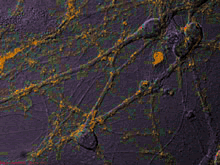
|
contact
lukecorp luke fritznews sciencedailywired space.com newscientist beyond 2000 links scientific americancosmic ancestry extropy webmonkey reading The Cyborg Handbook: Chris Hables Graylistening  weblogs eatonwebdamaged vavatch orbital archives 8.1.2000:8.31.20007.1.2000:7.31.2000 6.1.2000:6.30.2000 |

|
9.22.2000 OSU researcher Marc Madou has created an implantable "smart pill" that utilizes recent advances in artificial muscle technology. Of course the pill is still huge (2cm x 4mm), but it promises to drastically improve drug-delivery. Thanks to these muscles, precise amounts of drug can now be dispensed over a long period of time.
Hmm, is Japan ready to get back into the superpower game? Prime Minister Mori, outlining his plan for "Japan's rebirth" stated: "I will make Japan the world's leading information and telecommunications nation in five years," One of the reasons for Japan's lag in the great IT race is it's high telecommunications fees. Mori will work to build a network infrastructure, as well as work to make internet access more affordable. FACT: Sagittarius A is in fact the Milky Way's resident supermassive black hole, weighing in at about 2.6 million times the mass of our sun. An Arizona sized ice-reservoir has been discovered south of Valles Marineris. The implications are obvious, as human colonization will depend on plentiful water sources. This discovery makes colonization that much more realizable. FACTOID: The X-32 makes it's maiden voyage. BIZARRO: A fluorescent green bunny has been created.
An initiative to free the wireless web! Free access to anyone with the right equipment. Starting in East London. I'm very sorry, but I am having trouble getting a reliable internet connection back at school. I just moved into an apartment, and we only have one telephone line, which contrasts greatly from my previous T3 connection. Hopefully when classes start, I can resume regular programming. I hope you don't abandon my site because of this, and I am doing everything possible to rectify this situation. Cheers, Luke Celera Genomics announced it has found more than 2.8 million gene variations, called single nucleotide polymorphisms (SNP's, pronounced "snips"), which account for subtle variations such as hair color, pre-disposition to disease, etc. which is much higher than the 800,000 the SNP consortium originally thought. While reading through this Celera stuff, I noticed the Howard Hughes Medical Institute being mentioned for signing up to use Celera's SNP information. I also remembered that HHMI has created a protein chip, capable of measuring the function of thousands of proteins simultaneously, which could be a boon to proteomics research. My question is: Is HHMI planning to use Celera's SNP to identify proteins useful for medicine? If so, HHMI could come out with some awesome stuff in a few years. The town of Selma elects its first black mayor, to the rejoice of the black population of the town, and the dismay of the white trash that live there. It seems that, even in a city that was prominent in the civil rights movement, bigotry and predjudice still appear. Hopefully, the new mayor, James Perkins, will help reconcile this town. Here was a quote from the mayor I heard on the radio (may be slightly distorted in words but not meaning, I heard it this morning): I will not be the mayor for the black citizens of Selma, but for all citizens of Selma [...] When I say truth, I mean truth. When I say reconciliation, I mean reconciliation. New York is forcing its jail population to give up their DNA or face solitary. Hmm. FACTOID: Cows are genetically 83% identical to humans.
Hi, very busy, here's an article about Echidnas, and how they can help us find out about how our evolutionary survival strategies evolved, as well as making it possible for humans to finally get hibernation tech.
GADGET: If you've ever wondered why we don't yet have displays that look like sunglasses, it is because current consumer displays have low resolution, low refresh rates, and few colors (They also look dorky). Developments in light emitting organic displays have made Gibson-esque fantasies of donning your shades to jack in to the internet a reality. inViso and eMagin are coming to market with a revolutionary display-on-a-chip that are high resolution (800x600 to 1024x768), refresh rates of up to 106Hz, and even 16-bit color. It is now possible to make your own wearable computer using a laptop, a twiddler-style keyboard and one of these new displays. I'm still holding out for laser-based display technologies, because I'm still worried I will look like a complete dork. Something a little more like this below would be more acceptable...
During my plunge into the vast sea of information today, I encountered an interesting site dealing with cyberpunk (CP) information. If you don't know what CP is or what the theory behind it is, I suggest checking it out. Some good news (finally) from the Northwestern research circles... Apparently one of my chemistry professors, Chad Mirkin, has developed a technique for analyzing DNA that is much more cost effective than previous techniques. Without getting into the nitty-gritty, gold nanoparticles are coated with hundreds of copies of the target DNA, then they latch on to the targets and then the DNA is immersed into photograhic liquid, and silver ions attach to the gold, making the particles 100,000 times larger, which is scanned by a photo scanner. Your DNA could be scanned for as little as 100 bucks. The quest for beauty has reached a new low: Injecting botulinum toxin to decrease the appearance of fine lines and wrinkles. The technique works because the toxin paralyzes the small muscles in the face, preventing the "overuse" of the muscles which results in wrinkles. Dermatologist Kevin Pinski, M.D., Associate Professor of Clinical Dermatology at Northwestern University (tarnishing the name of my alma mater) had this to say about the procedure:
Another nanotech revolution: Scientists have figured out how to stop nanoscale devices from sticking together (atomic forces aren't negligible at this scale). Basically, they coated them in plastic - a very thin plastic coating! GADGET: The Modo. It's a cool device that tells you where all the hotspots and gigs are where you are using the GPS system. Should retail for under 100 bucks, and it's small enough to put on your keyring. Good news! Another life extender contender. The first time a drug has been shown to extend the lifespan of an animal. A drug that boosts the body's natural antioxidant system has extended the lifespan of nematode worms by 100 percent. Eukarion Inc, a private biopharmaceutical company in Massachusetts, synthesized two enzymes, superoxide dismutase and catalase. Then, British researchers added the enzymes to the liquid in which the nematodes were living. The problem is, due to the crazy trial process, we'd have to wait a couple hundred years to see if the drug works on humans, and then the drug could be approved. Manufacturing may be revolutionized by Gene Kirila, who has invented a system which will make anything, anywhere, as long as it can be molded. His Virtual Engineered Composites (VEC) process is basically a factory in a box. How does it work? It drapes two composite skins onto a foam model, then the skins thermochemically harden, then the cell is closed and filled with pressurized water, which braces the skins together. The composite materials are injected into the mold and catalyzed. What makes the process different is VEC's "floating mold"'s operating system which monitors 800 variables and constantly adjusts the water pressure and chemical balance. By using these techniques, Gene Kirila has managed to shave off 99% of the cost of tooling a mold. Thats what makes this a revolution. You will be able to airdrop one of these boxes anywhere on the planet and have it pump out piping one day, and boat hulls the next, with only a $25,000 retooling cost. Speaking of AI, Brandeis University DEMO Laboratory scientists have sucessfully bred robots that have created other robots. Although these robots are not von Neumann machines, the scientists did not intervene at all in the evolutionary design process of these robots. Similar to Karl Sims' work on evolving blocks that got successively better and better at swimming and walking, these robots first existed and evolved in a simulation. What makes these robots different to Sims' creations, are that they actually can be created in the real world, since they model joints and "bones".
Theres also a cool screensaver you can download from their site. If you want my opinion on the AI matter, I personally believe that it takes more than data to make something conscious. What makes our brains different from computers is the massively parallel architecture of neurons. This makes our brains well suited for pattern recognition, and I believe (rightly or wrongly) that the sum total of the thousands if not millions of pattern recognitions going on in the brains results in consciousness. This would also mean that self-awareness is gradually evolved, from rodent to human, infant to adult. Anyway, if AI is ever to occur, we must first mimic the structure of the brain, and then try to understand how the signals zipping around in it give rise to conscious perception. Oh, and if you submit a mindpixel, you get 20 shares of mindpixel stock.
|






